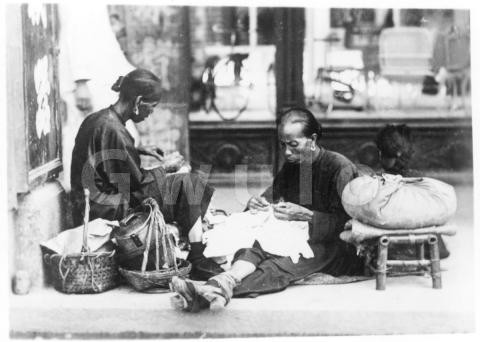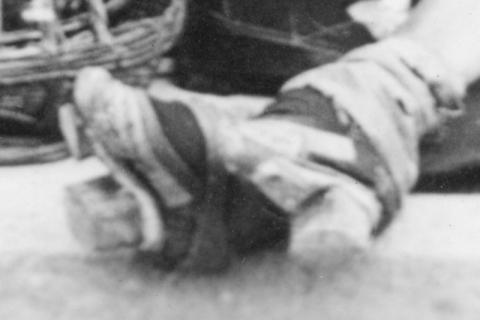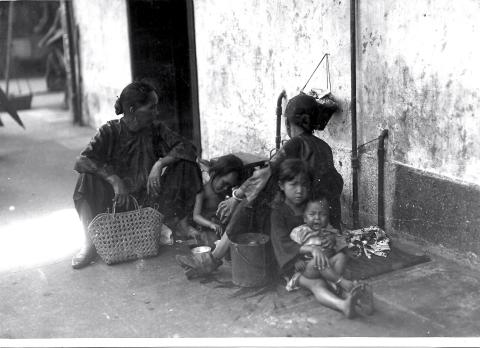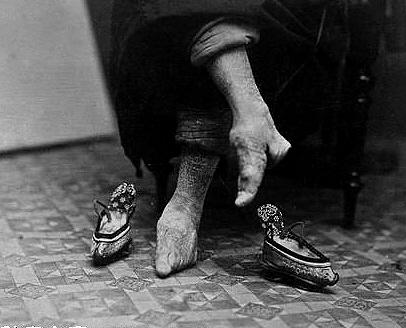This is the third and last of my recent purchases.
Who: The main characters are two 'sew-sew' women, who would mend and adjust items of clothing for a small fee. There is also a younger girl - probably a daughter of one of the women - with her back to us, leaning against the little stool on the right. I've just been writing about a similar photo for a section on hawkers in my next book, which is why this one caught my eye.
What: Their baskets carry scraps of material they use in their work, and also the pot that held their lunch.
The other photo I mentioned showed similar items, but under the magnifying glass I also noticed a difference.
The lady on the right has bound feet.
I couldn't think of any photos of bound feet in my collection, so this one was added to the shopping list.
Where: This photo came from the same seller as the previous photo of breaming, and was also identified as a Hong Kong scene.
This time we do get a clue that might confirm the location, though it isn't the clearest to see. These ladies often worked in the covered walk-ways that ran in front of Hong Kong's shop-houses, taking advantage of the shelter from sun and rain. On the left edge of the photo is one of the shop-house's pillars, with a sign showing the shop's name. Looking right from the pillar, behind the first lady is another sign and the shop's windows with goods on display. The background is too blurred to get a clear view of the goods, but I hope readers might be able to decipher the signs and tell us where the photo was taken. I've stretched the sign on the pillar, to make the character easier to read.
When: There aren't any notes to give us a date, but similar photos I've seen were taken in the 1920s or 30s.
Gwulo photo ID: ET003
Where are the other photos of bound feet in Hong Kong?
I'd read that foot-binding was widespread in China, so I got to wondering why I don't have any other photos of bound feet in my collection.
1. Maybe foot-binding wasn't carried out in Hong Kong?
No, that's not the reason. A writer on page 2 of the Hong Kong Daily Press, 1884-04-04 describes seeing it here:
[...] The back of my house overlooks some out-of-the-way Chinese quarters which Europeans seldom enter, and a day or two since, while upon the verandah, my attention was attracted by an incessant crying and moaning from among those houses. I could see the noise came from a girl, eight or nine years old, I should think, and with the aid of a pair of binoculars I made out the cause of her apparently agonised cries. Her foot were undergoing the process of crushing, and she was taken outside the house, and laid on bed boards, with two or three women around her. [...]
Then in 1915 Betty Steel arrived in Hong Kong, aged 5. In her memoirs, she remembers:
In our early days in Hong Kong we often saw women with bound feet, wearing tiny embroidered shoes. They moved slowly, leaning on the arms of servant girls, one on each side, because they could not walk alone.
2. But had it fallen out of fashion by the 1920s / 30s, when the photo was taken?
It was certainly disappearing from China by then, but was still more widespread than I expected:
In 1997, a study of older women in Beijing showed that the prevalence of bound feet was surprisingly high—38% among women older than 80 years and 18% among those aged 70 to 79 years.
Source: The “golden lotuses”: bound feet, from Hong Kong Med J 2016 Feb;22(1):90–1
If we estimate girls had their feet bound at age 7, the figures above show that even in to the 1930s almost one fifth of daughters born would have their feet bound.
Also, for many women the process was not reversible. Even though new cases of foot-binding were dropping rapidly in the 1920s / 30s, bound feet would still have been widespread among the adult female population at that time.
3. Perhaps Hong Kong had women with bound feet, but they just don't appear in photographs?
That could be part of the answer - as Betty Steel saw, having bound feet made it more difficult for women to get around. They'd have been more likely to stay at home, hidden away from the photographers.
4. Or they are in the photos, but I just haven't noticed them?
It's also true that I hadn't been looking out for them in the past. I've added a new tag, bound feet, to gather any I notice in future, but I don't think there will be many.
A search through photos on the site from other contributors to Gwulo found just two. The first one is from Betty Steel's collection, taken in the 1920s, and has some similarities with the scene shown above:
The other shows the effects of binding. One goal was to pull the four smaller toes under the ball of the foot so they are out of sight, the other was to compress the arch of the foot, bringing the ball of the foot unnaturally close to the heel.
5. Then were things different in Hong Kong from other areas of China?
I think that must be part of the answer too. The figures above came from Beijing in 1997. I haven't seen any similar figures for 1997 Hong Kong, but I feel sure they would be much lower.
So what caused the difference?
Was it a long-term regional difference? If we could time-travel back to 1800, would we see any major differences in the prevalence of foot-binding between the different regions of China? e.g. if there was much less of it in Guangdong than in north China at that time, it would be a reason for the difference in Hong Kong later, as most of Hong Kong's Chinese population moved here from Guangdong province.
I've also read that foot-binding wasn't the norm in the Hakka community, and I guess it would have been impractical for women living on boats, so even in pre-colonial times, those would be at least two groups of Hong Kong women who had natural feet.
During colonial times, missionaries were one of the groups promoting an end to foot-binding, so the large number of Christian schools and churches in Hong Kong would have contributed too.
Lots of guessing, so it's best that I stop here. If you can share any facts, especially any figures for the prevalence of foot-binding in Hong Kong over the years, and how they compared with the rest of China, please let us know in the comments below.
Further reading:
- Alicia Helen Neve BEWICKE (aka "Mrs Archibald Little") [c.1845-1926] campaigned against foot binding, She described hers as a secular approach, distinct from the missionaries, though their work overlapped.
- Gladys May AYLWARD [1902-1970], a Christian missionary, worked for the Chinese Government as a ‘foot inspector’ in the 1930s, helping implement a new law which had been passed prohibiting the practice of foot binding in young girls.
- Photos tagged sew-sew women
- Photos tagged bound feet






Comments
I remember reading somewhere…
I remember reading somewhere that the prevalence of foot-binding in the women of Guangdong province (which borders HK) was also lower c.f. the northern provinces as the women traditionally play a much more active role in all sorts of labour - including rural work - bound feet clearly being not conducive to toiling in the fields.
Foot-binding would be more prevalent in the higher socio-economic classes. The Chinese demographic that had migrated into and settled in colonial HK would also be more the labouring class which may translate to a lower prevalence of foot binding overall.
Words on the signs
Left - (?機)器 (?machine)
Right - 貨品 merchandise
Sew-sew women and bound feet
Left - 機 器 (= machinery) without the upper part of the first character.
Right - "環" 球 貨 品 (= Global merchandise) which literally means "Pan" Global merchandise, but without the first "Pan" character and without the upper part of the second character.
Same Women ?
Same women ? Have a copy of the main photo. Dated mine to the 1920s.
Sew sew women
This is actually my photo. It was taken by my grandmother in 1935, and has been posted by David, though without permission. The photo was in Kowloon near Haiphong Road.
You can't really generalize…
You can't really generalize an entire province of millions of women! I had to rack my brains as to where I read it years ago but I think I found it. The book "Women and Chinese Patriarchy: Submission, Servitude, and Escape", Edited by Maria Jaschok, Suzanne Miers, 1994 on page 29, mentioned about the anecdotal assumption by a westerner in the 1930s (not very scientific) of the lesser rate of footbinding in the south versus the north of China. But the presence of footbinding still did not preclude women from working in the fields!
David, I would be happy to…
David, I would be happy to talk to you about publishing my grandmothers photos, of which there are many, perhaps we can discuss? Nick
Beth Nance on foot binding
In her book 'My Life', Beth Nance talks of her growing-up years near Nanjing in China in the 1920s, and says this on foot binding:
'There were still women with bound feet, which was considered a sign of elegance of the upper class. It indicated that these women would have helpers in the household to do the rough work. It was not often that women of the peasant class had bound feet. I think that's probably why the families were so earnest about doing it.
My mother would never hire a woman with bound feet to carry us when we were babies. They might do other tasks around the house, but they could not be responsible for carrying the children. Mother was afraid they might fall because their feet were less than four inches long! It's ironic that such ugly torture was stuffed into beautiful embroidery.'
Having said that, she says that 'the Chinese made fun of American missionary ladies with their big feet. They'd say, "Americans don't understand how beautiful small feet are." The American women thought, "Who would want bound feet? Who would want to walk in pain with bound feet most of their childhood and not be able to run free and play?"'